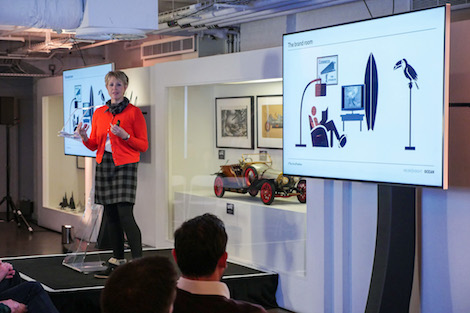New @OceanOutdoorUK Study Reveals Brand Building Power of Full Motion #DOOH
Adrian J Cotterill, Editor-in-Chief
Neuroscience research released last week demonstrates how full motion digital out of home campaigns are 2.5 times more impactful than content on static displays, delivering a powerful emotional experience comparable to that of television advertising.

The research, conducted by Neuro-Insight for Ocean Outdoor, used brain imaging to explore the neurological impact of digital out of home content on audiences. The study benchmarks the responses obtained against television and online video campaigns.
The third wave of Ocean’s Neuroscience research programme analysed brain response to full motion and static out of home adverts. The focus was on three key brain response metrics which, in combination, have been shown to correlate strongly with real world effectiveness: –
- Peaks in emotional response
- How positive that emotional response was
- The number of brand impacts encoded into memory
From the resulting responses, neuroscientists concluded: –
Ocean head of marketing Helen Haines told us “Previous neuroscience studies have established that iconic, large format advertising delivers heightened emotional response and strong memory encoding, and that this impact is heightened by full motion content. We also knew going into this study, that premium sites have a positive priming effect on other OOH advertising. This new study takes those learnings further to show that full motion content delivers 2.5 more brand impacts over static displays. We’ve now established that DOOH delivers brain responses that are comparable to that of television advertising and that it works in a similar way, delivering multiple impacts and a strong emotional response: two key components that contribute to driving real world sales.”
Ocean’s new study also measured short form video to see how it performed in DOOH environments compared to online and the results indicated that short-form online video content elicited higher levels of response when delivered via a full motion DOOH screen, and delivered more peaks of branded memory response. This means the presence of full motion DOOH alongside an online campaign gives opportunities to positively prime the brain to respond strongly to content when seen subsequently in an online context.
“Full motion DOOH is a growing delivery vehicle for short-form video content, but the study shows that it primes the brain to respond more strongly when the same content is viewed online. Which means online video campaigns will perform better if full motion DOOH is included in the media plan,”.
More generally, the study also demonstrated some characteristics of full motion DOOH that help drive high levels of positive brain response. Subtle (not necessarily overt) brand iconography, bright and contrasting colours and images of people and faces delivered a heightened sense of response when viewed within a DOOH environment.
Background Information
Hypothesis
Building on two previous neuroscience studies, the hypothesis was that DOOH played a similar role to television in helping to build brand equity and create strong emotional associations for advertisers. The second theory was that DOOH could amplify the impact of online advertising.
Methodology
Fieldwork was carried out in Manchester, where more than 100 participants took a walk past three static and full motion displays. DOOH campaigns for New Look, Netflix, Warburtons, Pixar, Tag Heuer and Gucci were among those tested.
Back in the study room, the participants watched a film of what they have just seen, headsets recording their brain responses to content on the displays.Neuro-research was chosen as the way of exploring impact, because it provides a means of looking at people’s emotional, sub-conscious responses, which are difficult to assess through traditional, questions-based research.
The technology used by Neuro-Insight known as Steady-State Topography (SST), records and measures electrical signals at the scalp in order to build a second by second picture of activity in the brain. All metrics used are based on measures that have been published and peer reviewed and are well-established in the field of neuroscience.

Follow DailyDOOH